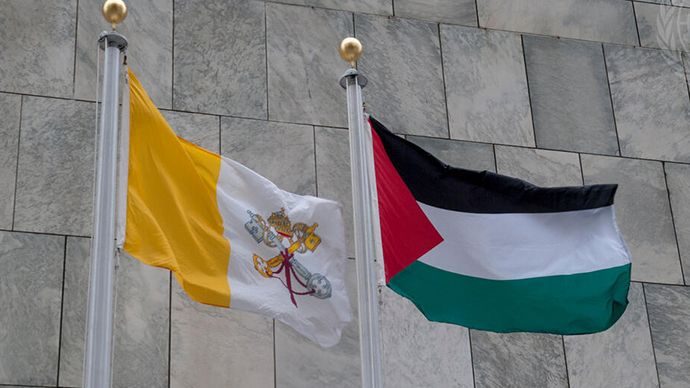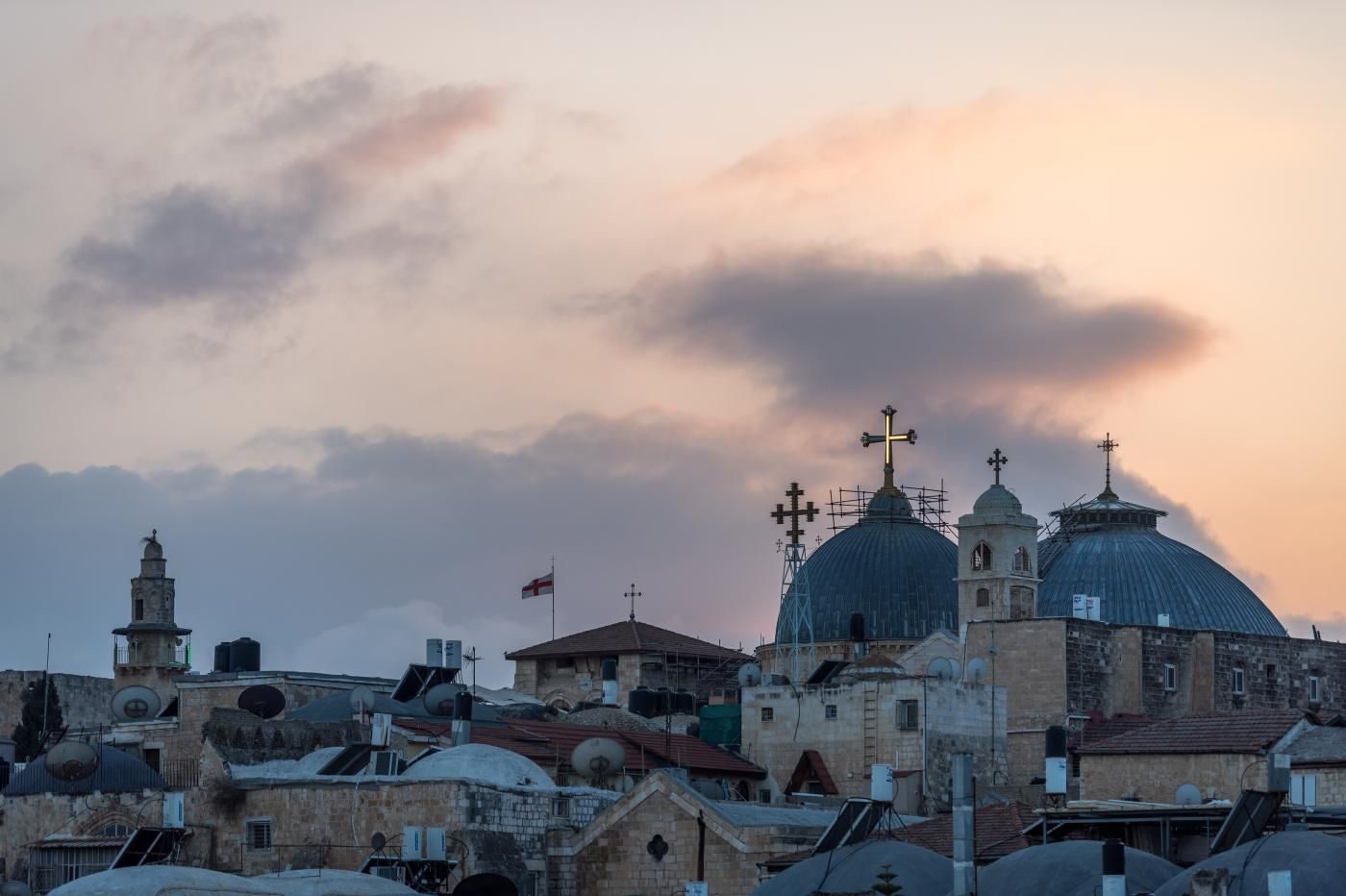The “Nakba,” the catastrophe, is the term used to describe the process of ethnic cleansing of Palestine of its indigenous population, the Palestinians. It initially involved the forcible displacement of over half of the Palestinian people and depopulating or erasing of at least 500 Palestinian villages, towns, and cities between December 1947 and 1949. The Nakba became an ongoing brutal reality for 75 years, with the people of Palestine suffering from the consequences of forced displacement and the denial of our right to self-determination and return until today.
Like all Palestinians, Palestinian Christians have been severely affected by the Nakba. After being over 10% of the population in 1948, the number dropped to almost 3% in one year. Many Palestinian refugees were moving toLebanon, Syria, and Jordan, but Christian Palestinian refugees settled primarily in Jordan and Lebanon. The number of Palestinian Christians who took refuge in Lebanon by 1948 is estimated at 40,000, while the number who took refuge in Jordan is estimated at 50,000.
This fact sheet sheds light on the particular case of Palestinian Christians who took refuge in Lebanon.
The Impact of the Nakba on Palestinian Christians
On 18 April 1948, the Palestinian city of Tiberias, on the shores of the Sea of Galilee, fell into the hands of Zionistgangs. Upon the city’s fall, Palestinians were put in trucks and expelled due to British–Zionist collaboration. Hundreds of faithful from the Latin (Roman Catholic), Greek Orthodox, and Protestant churches were among them. They were the first churches in Palestine to closeduring the Nakba.
As a result of the forcible expulsion of all the faithful, almost thirty churches belonging to different Christian denominations were forced to close. The list is long and includes the cases of Baysan (Greek Orthodox, Latin, and Episcopal Church), Jaffa (Episcopal Church), West Jerusalem (Episcopal Church, Armenian Church, and Latin Church – Terra Sancta), Safad (Greek Catholic Church), Al–Lydd (Latin Church), Ein Karem (Latin Church and the Orthodox Church witnessed the ethnic cleansing of their communities, yet the churches remained), Al–Mansoura – Safad (Maronite Church), Suhmata (Greek Orthodox Church and Greek Catholic Church), Al–Birwa (Greek Orthodox Church), Al–Bassa (Greek Orthodox Church, Greek Catholic Church, and Episcopal Church), Al–Mujaidyl (Greek Orthodox Church and Latin Church), Iqrith (Greek Catholic Church), Kufr Bir’im (Maronite Church), Ma’aloul (Greek Orthodox Church and Greek Catholic Church) and Shajara (Greek Orthodox Church).
In other cases, the communities of parishioners were severely diminished to less than 10% of their original parishioners, including in the important cities of Jaffa, Haifa, Akka, Al Lydd, Ramleh, and other towns and villages. Some church–related institutions were forced to close, while the Lutheran Church ceased to exist in all the territory seized by Israel in 1948. After 1948, churches and their related institutions continued to close, from the Armenian Community in Ittlit to Catholic institutions in Jaffa.
The forcible displacement of those communities involved documented cases of desecration reported to the United Nations by the various churches. Many examples of theheinous crimes perpetrated by the Zionist gangs in 1948include the Palestinian village of Eilabun, near Nazareth, where 12 Palestinian Christians were executed following the village’s fall on 30 October 1948. Another example is the terrorist attack on the Semiramis Hotel in Qatamon, in Jerusalem, where the terrorist Haganah group killed 25 Palestinian Christians and the Spanish Deputy Consul after blowing up the hotel.
Palestinian Christian Refugees in Lebanon
Whether in boats from Jaffa, Haifa, and Acre (Akka), in trucks from the upper Galilee, or simply by walking, thousands of Palestinians arrived in the Lebanese cities of Sour, Saida, and the capital Beirut in the months following the beginning of the Nakba. Among them were members from all walks of Palestinian society, from peasants to medical doctors to businesspeople and others.
Palestinians that moved to Lebanon contributed to the construction of the modern Lebanese Republic, including many Palestinian Christians. This includes the Khoury and Talamas families, previously famous for orange export to Europe, the Gargour family, which continued in Lebanon with the Mercedes Benz cars for the Middle East, and the Tannous family from Jerusalem, which continued having the franchise of General Motors.
Yousef Beidas, a Palestinian Christian who became known as the “Genius of Jerusalem,” is related to the development of the Banking system in Lebanon through the Intrabank as well as by turning Middle East Airlines, Lebanon’s carrier, into one of the leading airlines in the region. Other Palestinian Christians, such as Mounir Haddad and Emile Mousallam, invested massive capital in the Lebanese banking system, whereby Lebanon attracted some of the Palestinian fortunes saved from the Nakba. Years passed, and other Palestinians significantly contributed to the Lebanese Republic, including the foundation of the CCC Company, a leading Construction Company in the Middle East founded by Sa’id Khoury and Hassib Sabbah, two Palestinian Christians from Safad.
The influx of many Palestinian refugees into Lebanon also affected the fragile demographic distribution of the country upon which its political power had been built. With a significant part of Lebanese Christians having immigrated under the Ottoman and French occupations, some members of the Christian parties in control of the country agreed to provide several Palestinian Christians with citizenship after 1948. Between 1949 and 1952, around 31,000 Palestinian Christians were granted Lebanese citizenship.
However, not all Palestinian Christians received citizenship. “We remained in an area close to the border, between Sour and Ras Al–Naqoura, until there was a decision to remove all Palestinian refugees from that area.This is how we moved to Beirut. Initially, we were not interested in anything but in returning home, including by staying as close as possible to Palestine,” said George, whose family made it to Lebanon from Haifa when he was nine years old. George gained Lebanese citizenship laterbut carried Palestinian refugee papers for many years.
Palestinian Christians without Lebanese citizenship lived in and outside refugee camps. Many relied on education provided by UNRWA schools, while few received church support. The Joint Christian Committee, representing all churches in Lebanon except the Maronite Church, founded the “Department of Service for Palestinian Refugees” in 1950, which provided extensive support,including educational and health services and community empowerment.
Two refugee camps were entirely inhabited by Palestinian Christians, both in East Beirut, Dbayeh and Jisr Al-Basha. They hosted people from various religious denominations,including Greek Catholic, Greek Orthodox, Latin, Maronite,and Armenian – Palestinians. Christian Palestinian refugees were also concentrated in the refugee camps of Mar Elias in Beirut and Al Buss between Saida and Sour in the south.
Other Palestinian Christians concentrated in the popular neighborhood of Burj Hammoud and around Al–Hamra. At least six churches were identified as “Palestinian,”including in Jisr Al–Basha and Dbayeh camps and theGreek Orthodox, Greek Catholic, Latin, and Episcopal churches in the Al–Hamra area. Palestinians also integrated into various parishes elsewhere in Lebanon, including Palestinian Armenians joining Armenian communities in Burj Hammoud.
The Cost of Israeli Aggressions Against Palestine’sRefugees in Lebanon
Having survived the Nakba of 1948, Palestinian refugees in Lebanon endured several horrific events, including repeated Israeli bombardments that killed thousands and injured many more in the 1960s and 1970s. In Septemberof 1972, for example, at least 200 Palestinian refugees were killed in Israeli bombardments against Palestinian refugee camps in southern Lebanon.
In 1976, the Palestinian refugee camps in East Beirut came under heavy fire, including Jisr Al–Basha, home to 3,000 Palestinian Christians. The bombardments resulted in 158 Palestinian Christian martyrs. Dozens of Palestinian Christian families were also displaced from the Dbayyeh refugee camp. Some families were resettled in buildings rented by the Palestine Liberation Organization (PLO) in Beirut. As part of the Israeli siege of Beirut in 1982, one of those buildings was destroyed, and around 100 Palestinian Christian refugees were killed.
No Freedom of Worship for Palestine’s Refugees
The Nakba and the Israeli occupation forever changed several ancient traditions practiced by Palestinian Christians, including freedom of access to holy sites. Based on a survey conducted with 50 Palestinian Christians in Lebanon in April 2023, all considered religious pilgrimage as “very important,” with many stating that their dream is to pray in the Holy Sepulcher. People of all ages were generally willing to exercise their right of return, including those who acquired Lebanese citizenship.
Some refugees pointed out that Christian pilgrims from Western countries are welcome to visit Palestine, while Palestinian Christians are even denied the right to see their homeland. In addition, they expressed frustration with certain Western religious leaders who praise Israel without considering the plight of Palestinians in general and the situation of Palestinian Christians in exile in particular.
A “spiritual crisis” followed the Nakba of 1948. In particular, Palestinian Christians have found it hard to understand why foreign Christians celebrate their catastrophe as a “miracle“ or a “divine message.” There aren’t just Christian Zionists celebrating, but also members of traditional churches. In a video message made by the German Embassy in Tel Aviv ignoring the Palestinian Nakba in celebration of the 75th anniversary of the State of Israel, a German Catholic priest based in Jerusalem stated: “Forme, Israel is an incredibly exciting state, that asks right from the start: For whom do I want to be a state? How do I want to be state? (…).” Is it possible for this priest and his likes to look at the Palestinian people’s suffering, including that of the Palestinian Christian refugees in Lebanon, during the past 75 years?
The Christian Presence in Palestine
If the Nakba had not occurred, population projections indicate that there would have been more than 800,000 Palestinian Christians in the Holy Land today.
Over thirty parishes closed in Palestine as a direct consequence of the Nakba. At a time that several western religious and political leaders have expressed concernabout the situation of Christians in the Middle East, it is telling that almost none of them have raise the situation of the Palestinian people, including the right of return. According to current estimates, there are between 800,000 and 1,000,000 Palestinian Christians worldwide. But in historic Palestine, there are close to 200,000 Palestinian Christians. As a result of the Nakba and its consequences, less than a fifth of Palestinian Christians can celebrate Christmas at the Nativity Church of Bethlehem. The rest require permits issued by the Israeli occupation.
While the wrongs and crimes perpetrated against Palestinian people continue with impunity and disregard for international law, the Israeli occupation continues to exploit the lands and properties belonging to the Palestinian people. Since the beginning of the Nakba in 1948, Israel has set a system that gives Jews worldwide exclusive rights in the land of historic Palestine and denies and strips the Palestinian people of their rights. Byimposing a system of Jewish supremacy, Palestinians are discriminated against due to their faith and nationality.








